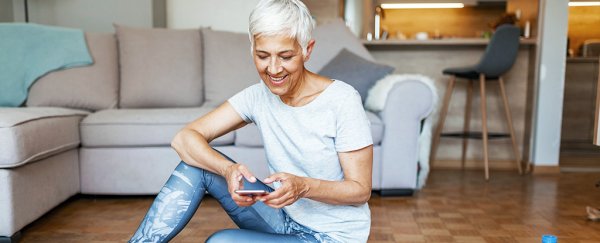One of the most frustrating things about getting older is when the pounds pile up along with the years. Keeping weight off can be a challenge, even when you aren't eating more or exercising less.
But don't be discouraged. Aging may be inevitable, but getting fatter need not be.
Obesity affects about 40 percent of American adults, including the young and middle aged, an estimated 93.3 million adults, according to the Centers for Disease Control and Prevention.
It is a serious public health problem, raising the risk of Type 2 diabetes, heart disease, stroke and certain cancers.
One big reason we gain weight as we get older is because we gradually lose muscle mass, about 1 percent every year, says Donald D. Hensrud, associate professor of preventive medicine and nutrition at the Mayo Clinic College of Medicine.
This causes a decrease in our basal metabolic rate, that is, the process of burning calories while we are at rest. The lower the metabolic rate, the fewer calories we burn.
"It may be imperceptible year to year, but compare the amount of muscle mass with the average 80-year-old to the average 20-year-old and it becomes more apparent," says Hensrud, also medical director of the Mayo Clinic's Healthy Living Program.
"The greater the amount of muscle mass we have, the greater our resting metabolic rate."
Also, spontaneous physical activity - separate from exercise - often ebbs with age, he says.
"In general, the average 80-year-old will move less in small and big ways throughout the day compared to the average 20-year-old," Hensrud says.
"And exercise, separate from daily activity, probably declines, although that only affects in a large way the smaller proportion of people who exercise regularly."
Bethesda dietitian Jessica Murgueytio agrees.
"Many of my patients admit to moving less overall as they get older, and the first thing I recommend for weight loss is to add weight training - at least two to three days per week - to slow down sarcopenia (age-related muscle loss), along with an additional day or two of cardiovascular exercise," she said in an email.
She suggests working with a personal trainer, especially on weights, to learn to lift safely and effectively.
"On top of this, I encourage my patients to meet the 10,000 steps per day goal, so they are taking walks throughout the day or doing house or yard work, vs. getting home from the gym and sitting all day," she said.
"This will also impact metabolic rate."
Changes in hormones - declines in testosterone in men and estrogen and progesterone in women - also can affect weight. But it's a false assumption that postmenopausal women gain more weight than men, Hensrud says.
Rather, both sexes gain, but weight tends to redistribute in women more quickly than in men, often ending up in the abdomen - one reason for this misperception.
"Weight gain seems to affect men and women similarly," he says, typically about a pound or more annually, often between Thanksgiving and New Year's.
"This doesn't seem like much, but on a population-wide basis it adds up to quite a bit," he says.
"It is cumulative. It stays on. So, after 20 or 30 years, it adds up. During menopause, weight gain [in both sexes] is about the same. But [in women] weight shifts more toward the abdominal region, so it appears to be greater weight gain. The same thing happens in men - greater weight gain with age in the abdominal region - but it occurs more gradually."
There also may be physiological influences at work. A recent study suggests that lipid turnover in adipose tissue (where the body stores fat) decreases during the aging process, meaning the removal of fat from fat cells slows down, contributing to weight gain.
Researchers studied the fat cells in 54 men and women during a 13-year span, and all of them showed declines in their rate of lipid turnover.
The results indicate that processes in the fat tissue "regulate changes in body weight during aging in a way that is independent of other factors," says Peter Arner, of the Karolinska Institute in Sweden and one of the study's main authors, along with collaborators from Uppsala University in Sweden and University of Lyon in France.
Experts suggest people keep exercising regularly, monitor calories, lift weights and move throughout the day, avoiding sitting as much as possible.
"All types of physical activity burn calories and are important," Hensrud says.
"Resistance training [weightlifting] helps lose abdominal fat. Exercise is the most efficient way to burn calories," especially high-intensity interval training, or HIIT, that is, short bursts of intense exercise followed by brief recovery periods.
"[HIIT] has also been shown to help lose abdominal fat," he says. "Moving throughout the day instead of sitting can also help burn a relatively large amount of calories."
Murgueytio warns that if exercise and muscle mass wane, it's important to compensate by cutting calories.
"I encourage my patients to work on portion control and eating a higher volume of lower calorie foods, like fresh fruits and vegetables, since they will fill us up with less total calories and are important for aging, vitality and disease prevention," she says.
The good news is that weight gain seems to stabilize after the mid-60s, in part because people often eat less when they get older, Hensrud says.
Obesity among those older than 60 is about 41 percent, compared with nearly 43 percent for people ages 40 to 59, and 36 percent for those 20 to 39, according to the CDC.
"Although physical activity probably continues to decline throughout the life span, energy [calorie] intake also tends to decline in the elderly," he says.
2019 © The Washington Post
This article was originally published by The Washington Post.
